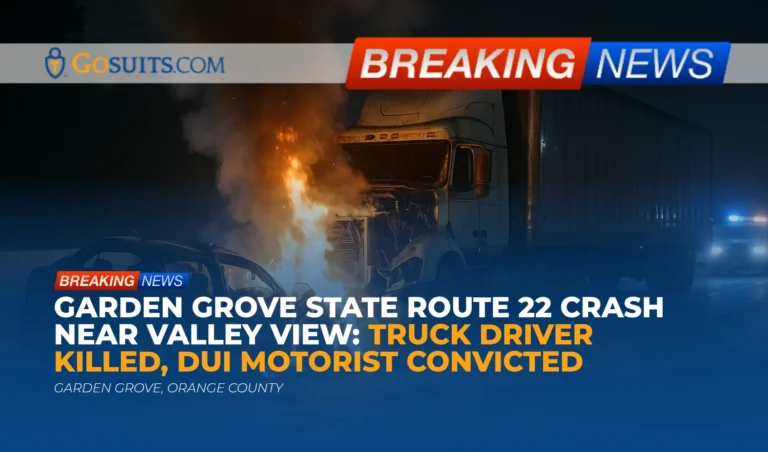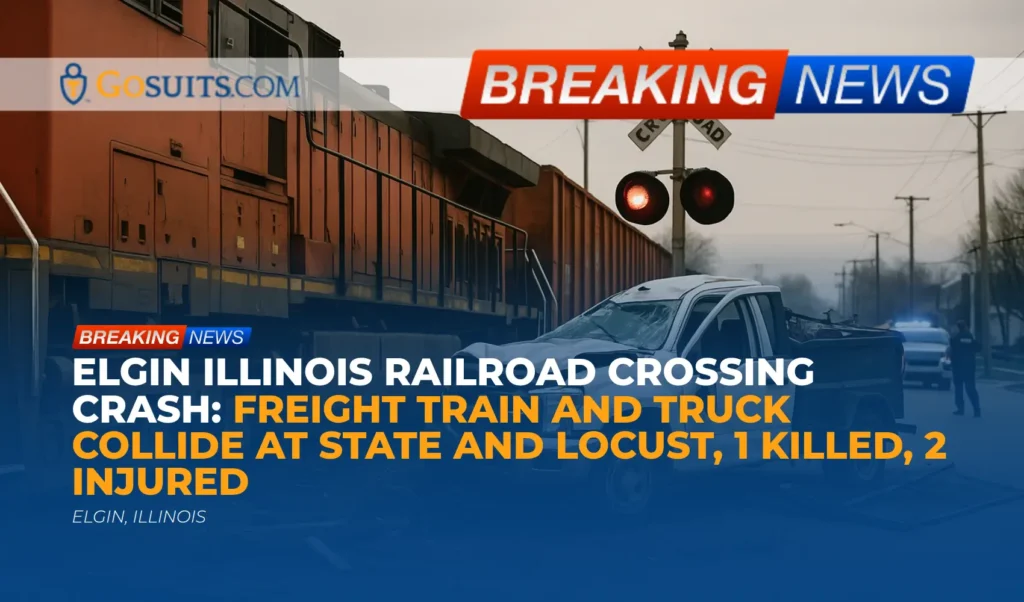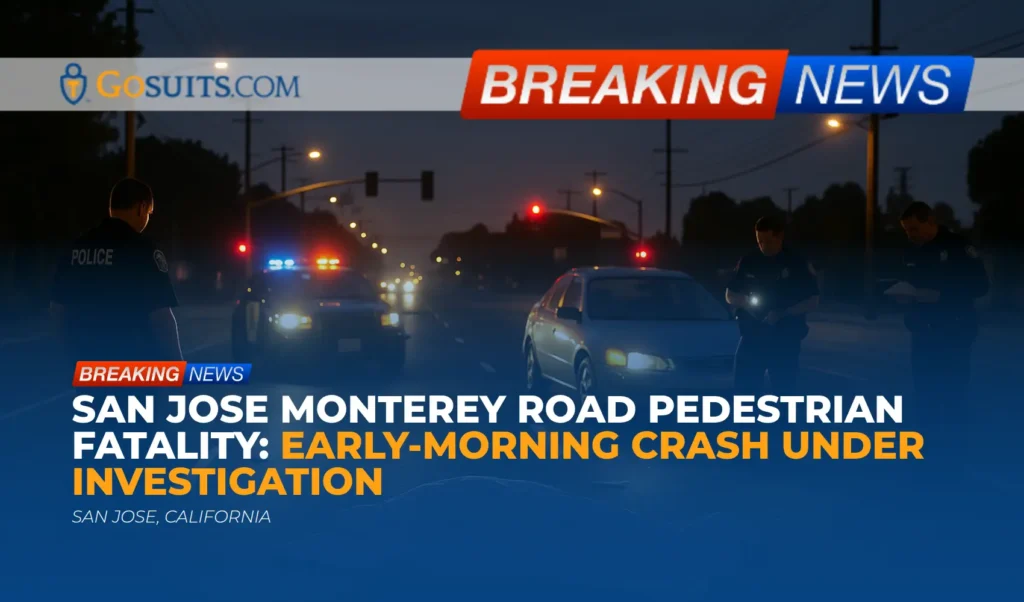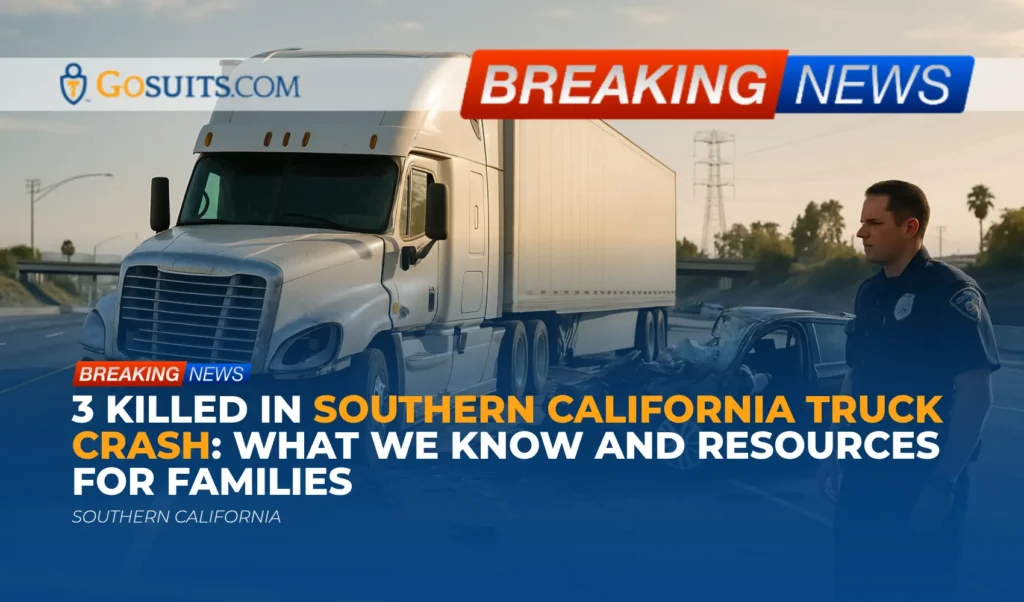- What Happened on State Route 22 in Garden Grove
- What Officials Reported and Current Case Status
- Where the Crash Occurred and Why Location Matters
- How Families Can Obtain Official Records
- Civil Remedies After a Fatal Crash in California
- Potential Liability Considerations in This Scenario
- Insurance Issues After a Fatal Freeway Collision
- Critical Evidence: Vehicle “Black Box” Data, 911 Calls, and More
- Impaired Driving Risks and Safety Context
- Support and Public Programs That May Help
- Time Limits and Legal Deadlines to Know
- Practical Steps to Consider Now
- Next Steps and Why Acting Promptly Matters
- Commentary from Gosuits Garden Grove, California Personal Injury Attorney
What Happened on State Route 22 in Garden Grove
On June 9, 2019, a tragic chain of events unfolded on the eastbound State Route 22 in Garden Grove, Orange County. According to public statements later summarized by county officials and reported by local media, a 33-year-old Irvine driver crashed his Honda into a guardrail near Valley View Avenue. The Honda was reportedly left disabled, blacked out, and facing the wrong way. Within minutes, a semi-truck collided with the disabled Honda, igniting a fire. The truck driver, a 58-year-old man, died at the scene.
In the years that followed, prosecutors brought charges related to impaired driving and vehicular manslaughter. A jury verdict was announced in 2025, several years after the crash. While the criminal case addressed violations of law and potential punishment, families often have separate and distinct civil remedies that focus on accountability and compensation for losses caused by negligence. This article explains, in plain language, what those civil options generally look like in California and where families can turn for official records and support programs.
What Officials Reported and Current Case Status
Officials stated that the Honda’s event data recorder captured a speed of approximately 89 miles per hour five seconds before the initial guardrail impact, and responding officers reported locating vehicle parts and noted signs of alcohol. The region’s emergency dispatch received calls about the semi-truck striking the disabled Honda and bursting into flames. The truck driver was pronounced deceased at the scene. In 2025, a jury convicted the Honda’s driver of gross vehicular manslaughter while intoxicated and related DUI offenses; sentencing is scheduled in early 2026.
Criminal proceedings determine guilt and potential punishment under criminal statutes. They do not directly resolve the civil claims of a victim’s family, which are typically pursued through wrongful death and survival actions in civil court. Families often need official records—such as the California Highway Patrol (CHP) collision report and the coroner’s records—to help assess civil options.
Where the Crash Occurred and Why Location Matters
The incident occurred on the eastbound lanes of State Route 22 near Valley View Avenue in Garden Grove, Orange County. Because the crash happened on a state freeway, the lead investigating agency is typically the California Highway Patrol. Knowing the exact location and investigative agency helps families request the right records, preserve evidence, and identify any public entities that might have been involved in roadway maintenance or traffic management.
If a collision occurs on a city street, local police usually take the lead. On state highways and freeways, the CHP is generally the custodian of the official collision report. Families can use the CHP’s online resources to identify the appropriate Area Office that handled the investigation and to request reports using the CHP’s process. See CHP’s collision report request information at chp.ca.gov and find the correct Area Office via chp.ca.gov/find-an-office.
How Families Can Obtain Official Records
CHP Collision Report and Photographs
The CHP collision report often includes diagrams, involved parties, witness statements, and preliminary findings. To request a CHP report, families can use the CHP 190 form and follow the instructions provided by CHP at chp.ca.gov/notify-chp/collision-report-request. The report may also include or reference photographs, supplemental narratives, and measurements. Some materials are restricted, and release may depend on status as next of kin or a legal representative.
Coroner and Autopsy Records
In Orange County, the Sheriff-Coroner’s Office manages medicolegal death investigations. Next of kin can contact the Orange County Sheriff-Coroner for information about reports, timelines, and the process for requesting records. The Sheriff-Coroner’s website is available at ocsheriff.gov and includes information about the Coroner Division. Families can inquire regarding the availability of the coroner’s report, toxicology (if performed), and related documents.
Death Certificates
Certified death certificates are typically obtained through county or state vital records. In California, the Department of Public Health provides information on obtaining death records at cdph.ca.gov. Families will usually need certified copies for insurance claims, probate, and other legal or administrative matters.
911 Audio, Dispatch Logs, and Public Records
Families may request 911 audio recordings and dispatch logs, which can be crucial in understanding timelines and response efforts. Requests typically go through the public agency that handled the calls—often the CHP for freeway incidents. Public records laws can allow access to certain materials, though some items may be exempt or redacted. Check the CHP Area Office website and use the contact resources at chp.ca.gov/find-an-office to ask about the right process.
DMV Accident Reporting Requirement
California requires motorists to file an SR‑1 accident report with the DMV within 10 days when a crash involves injury, death, or property damage above a specified threshold. Details and the SR‑1 form are provided by the California DMV at dmv.ca.gov. While this duty typically falls on drivers and owners, families handling administrative matters should be aware of this requirement when applicable. See the DMV’s SR‑1 information page by searching “DMV SR‑1” at dmv.ca.gov.
Civil Remedies After a Fatal Crash in California
Wrongful Death Claims
California’s wrongful death law allows certain family members to seek damages for losses they suffer when a loved one is killed due to another’s wrongful act or neglect. The statute describing who may bring a wrongful death claim is California Code of Civil Procedure section 377.60, available at the official legislative site leginfo.legislature.ca.gov. Eligible claimants may include a surviving spouse, domestic partner, children, and others who were financially dependent on the decedent as outlined in the statute.
Damages in a wrongful death claim may include loss of the decedent’s financial support, value of household services, and loss of love, companionship, comfort, care, assistance, protection, affection, and moral support. The exact categories and measures of damages are determined by statute and case law; courts assess them based on evidence particular to each family.

Survival Actions
Separate from a wrongful death claim, a “survival action” allows the decedent’s estate to recover damages the decedent could have pursued had they lived, such as medical expenses incurred before death and certain other losses. Survival actions in California are authorized by Code of Civil Procedure section 377.30, accessible at leginfo.legislature.ca.gov. Survival actions are brought by the decedent’s personal representative or, under some circumstances, by successors in interest.
How Criminal Proceedings Relate to Civil Claims
A criminal conviction focuses on punishment and public safety. Civil claims focus on accountability to the victims’ families and compensation for damages allowed by law. The two processes are distinct. Evidence developed in a criminal case can sometimes be useful in civil matters, but the civil case must still be proven according to civil standards, which differ from criminal standards.
Potential Liability Considerations in This Scenario
Public statements about this crash describe a vehicle that struck a guardrail and was left disabled, unlit, and facing the wrong way on a freeway, followed minutes later by a fatal collision when a semi-truck struck the disabled car. When evaluating civil liability, several issues commonly arise:
- Impaired or unsafe driving: Operating a vehicle while impaired, or at unsafe speeds, can support findings of negligence in civil court because drivers owe a duty of reasonable care to others on the road.
- Leaving a disabled vehicle in a dangerous position: A driver’s conduct in leaving a vehicle disabled, unlit, or facing oncoming traffic may be scrutinized in terms of foreseeability and the reasonableness of steps taken to prevent harm.
- Comparative fault: California follows comparative fault principles, meaning a jury can assign percentages of responsibility among the parties involved. Even where one person’s conduct is the primary cause, other factors can be considered. The specifics depend on the evidence in each case.
- Alcohol service liability is limited in California: California generally does not impose civil liability on a bar or restaurant for serving alcohol to an adult who later causes injury, with narrow statutory exceptions (such as providing alcohol to an obviously intoxicated minor). See California Civil Code section 1714 at leginfo.legislature.ca.gov.
- Potential public entity issues: In some cases, families ask whether roadway conditions or lighting contributed. Claims against a public entity, if any, have special procedures and short deadlines, discussed below. Whether such claims are viable depends entirely on the facts and expert evaluations.
Each crash is fact-specific. Accident reconstruction, vehicle data, witness statements, and scene evidence often play central roles in determining civil responsibility.
Insurance Issues After a Fatal Freeway Collision
Insurance coverage is a practical component of civil recovery. In a scenario like this, several types of coverage may be implicated:
- At-fault driver’s auto liability: Bodily injury liability coverage is typically the first policy pursued. Limits vary widely and can be insufficient in catastrophic losses.
- Employer-related coverage: If the decedent was driving in the course of employment, workers’ compensation death benefits may be available. The trucking company’s policies may also be implicated depending on the facts.
- Uninsured/Underinsured Motorist (UM/UIM): If the at-fault driver is uninsured or underinsured, UM/UIM coverage attached to the decedent’s personal policy or a household policy may provide a secondary recovery source.
- Umbrella or excess policies: Some individuals and businesses carry excess policies that sit above primary limits. These can be crucial in severe loss cases.
Insurance adjusters often move quickly to obtain recorded statements and medical or employment records. It is prudent to speak with a qualified attorney before providing statements to any insurer. Statements can be used later to limit or dispute a claim. California’s Department of Insurance publishes consumer information and rules governing fair claims handling at insurance.ca.gov.
If considering any insurance claim, consult an attorney first to understand rights and obligations. What is said to insurance companies can be used against claimants later.
Critical Evidence: Vehicle “Black Box” Data, 911 Calls, and More
Modern passenger vehicles often contain an Event Data Recorder (EDR), sometimes called a “black box.” EDRs can record a snapshot of speed, brake application, throttle position, seatbelt status, and other parameters immediately before a crash. The National Highway Traffic Safety Administration explains EDRs and their role in crash investigations at nhtsa.gov. Preserving access to the vehicles is key to safeguarding this data.
Beyond EDR data, other evidence that can be critical includes:
- 911 audio and dispatch logs: These can document the timing of events and eyewitness descriptions.
- Photographs and scene measurements: From law enforcement and independent investigators, these help establish positions and trajectories.
- Commercial vehicle records: For a tractor-trailer, data may include electronic logging device (ELD) records, GPS, maintenance logs, and cargo documents.
- Medical and coroner records: Establish injuries, causation, and timing issues that may be relevant to damages and survival claims.
Because some evidence can be lost or overwritten over time, prompt preservation is important. Families’ representatives often send preservation notices to involved parties to help ensure critical materials are not destroyed in the ordinary course of business.
Impaired Driving Risks and Safety Context
Impaired driving is a persistent safety crisis. The National Highway Traffic Safety Administration reports that in 2022, 13,524 people were killed in alcohol-impaired driving crashes in the United States, averaging one death every 39 minutes. See NHTSA’s impaired driving page at nhtsa.gov. These numbers underscore the predictable and devastating nature of impaired driving crashes.
Public health agencies also document how crash risks increase with blood alcohol concentration and how preventive choices—designated drivers, rideshare, and public transportation—reduce harm. The Centers for Disease Control and Prevention provides educational resources on impaired driving risks at cdc.gov.
Support and Public Programs That May Help
- California Highway Patrol (CHP): For the official collision report and related materials, use the CHP collision report request process at chp.ca.gov and locate the relevant Area Office at chp.ca.gov/find-an-office.
- Orange County Sheriff-Coroner: For coroner and autopsy record information, visit the Sheriff-Coroner’s site at ocsheriff.gov and navigate to the Coroner Division.
- Vital Records (Death Certificates): Obtain certified death certificates through the California Department of Public Health at cdph.ca.gov.
- California Victim Compensation Board (CalVCB): Provides financial assistance for certain crime-related expenses for eligible victims and families. Learn more at victims.ca.gov.
- California Department of Insurance: Consumer information on dealing with insurers and claims processes is available at insurance.ca.gov.
These agencies can help families gather documentation needed for insurance claims, probate, and potential civil cases. Response times and eligibility requirements vary, and some records are released only to next of kin or authorized representatives.
Time Limits and Legal Deadlines to Know
California imposes strict time limits on civil claims:
- General personal injury and wrongful death: California Code of Civil Procedure section 335.1 generally provides a two-year time period to file such lawsuits. The statute’s text is available at leginfo.legislature.ca.gov.
- Claims involving public entities: If a public entity is a potential defendant, a governmental claim typically must be presented within six months of the incident under Government Code section 911.2, found at leginfo.legislature.ca.gov.
There are exceptions and nuances that can extend or shorten these periods, especially where minors, estates, or public entities are involved. Because deadlines can be unforgiving, it is wise to consult an attorney promptly to understand which rules apply to a specific situation.

Practical Steps to Consider Now
- Preserve documents and evidence: Keep any photographs, video, vehicle information, and communications. Request official records from the CHP and the Coroner as outlined above.
- Obtain certified death certificates: These will be needed for insurance claims and estate matters. Use the CDPH vital records resources at cdph.ca.gov.
- Coordinate with the investigating agency: Note the report number, investigating officer, and Area Office. Follow up on supplemental reports or pending lab results, if any.
- Do not give recorded statements to insurers before legal guidance: Insurance companies may request interviews quickly. Speak with an attorney first. What is said early can impact claim value and defenses raised later. See consumer guidance at insurance.ca.gov.
- Consider probate and estate issues: A survival action requires a personal representative or successor in interest. Families may need to open an estate in the appropriate county.
- Track all expenses and losses: Funeral costs, loss of earnings, benefits, and services should be documented. This information is often required by insurers and courts.
- Explore public benefits and assistance: Review CalVCB eligibility at victims.ca.gov.
Next Steps and Why Acting Promptly Matters
Acting promptly helps ensure that time-sensitive evidence is preserved, statutory deadlines are met, and benefits or assistance are not delayed. Here is what timely action accomplishes and why it matters:
- Protects critical evidence: Vehicles are repaired, sold, or salvaged; electronic data is overwritten; 911 recordings can be subject to retention limits. Early preservation can prevent permanent loss of important proof.
- Clarifies coverage and benefits: Insurance coverage and employer-related benefits may require prompt notice or filings. Early review helps avoid missed windows.
- Avoids deadline pitfalls: California’s statutes of limitations and government claim statutes are strict. Starting early reduces the risk of losing claims on procedural grounds.
- Supports informed decision-making: With records in hand and a clear understanding of options, families can make choices that reflect their goals and needs.
The concrete steps often include requesting official reports, securing the vehicles and their data, organizing financial and employment records, and consulting with a seasoned attorney before interacting with insurance carriers.
Commentary from Gosuits Garden Grove, California Personal Injury Attorney
Our hearts go out to the family of the truck driver whose life was lost in this freeway tragedy. This article is intended for general information and educational purposes, to help community members understand the civil landscape after a fatal crash.
From a civil perspective, the facts publicly described raise serious concerns about the foreseeability of harm when a vehicle is left disabled, unlit, and facing the wrong direction on a busy freeway, and about the extreme risks tied to impaired driving. Event data recorder information, dispatch timelines, and physical evidence typically become key in demonstrating the chain of causation and the reasonableness of each person’s conduct.
In the aftermath of a catastrophe, insurance companies and corporate defendants often move fast to shape the narrative. Adjusters may seek early statements or records that can be used later to minimize responsibility or dispute damages. There can be multiple layers of coverage, each with different obligations and exclusions, and carriers may leverage that complexity to delay, deflect, or reduce payments. This is why speaking with an attorney before giving recorded statements or signing authorizations is so important; it levels the playing field and helps protect important rights.
A free consultation can be invaluable. It allows families to ask questions, understand the difference between wrongful death and survival actions, identify all available coverage, and learn the immediate steps to preserve evidence and meet deadlines. Even a single conversation can provide clarity at a time when decisions feel overwhelming. While no outcome can be guaranteed, informed choices made early often have a meaningful impact on the path forward.






